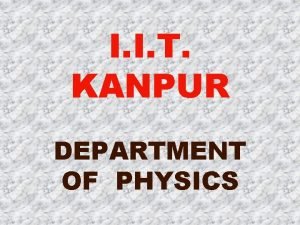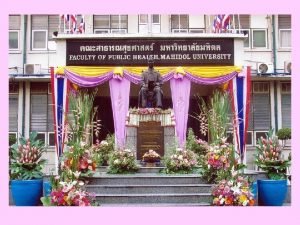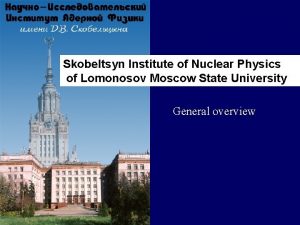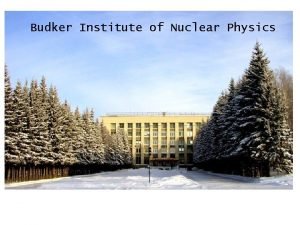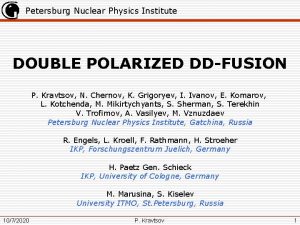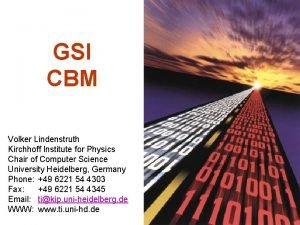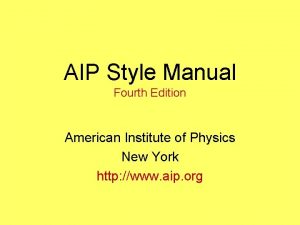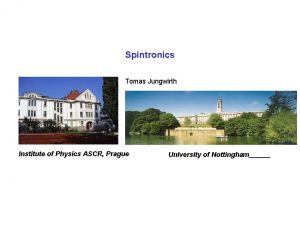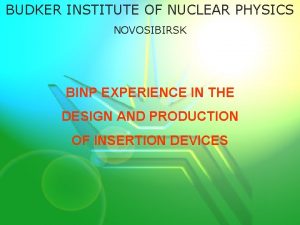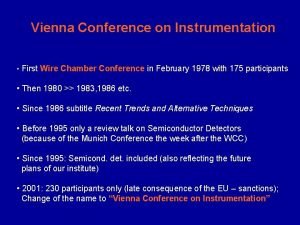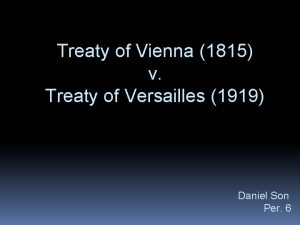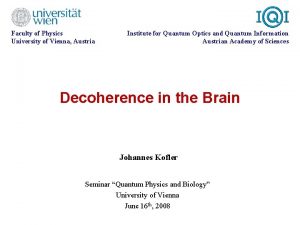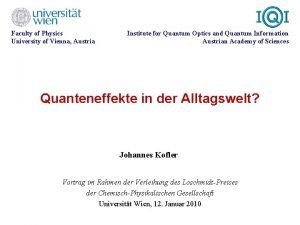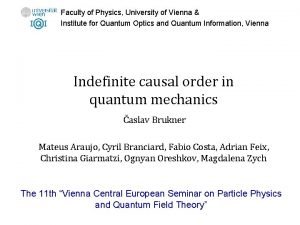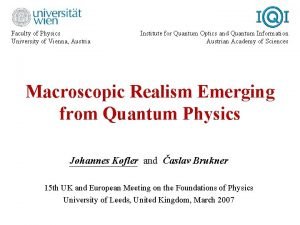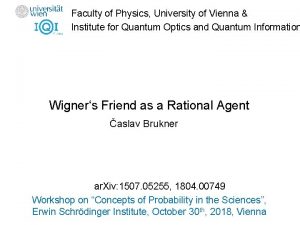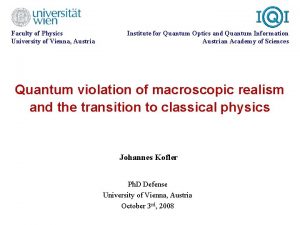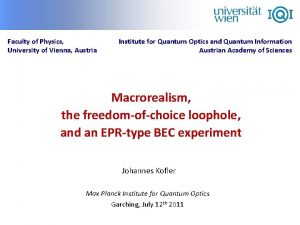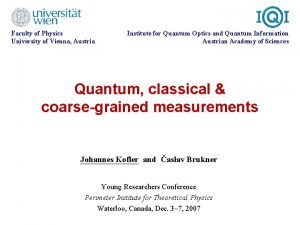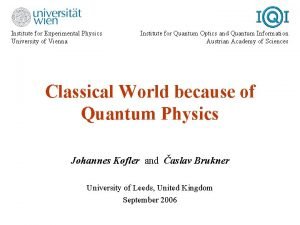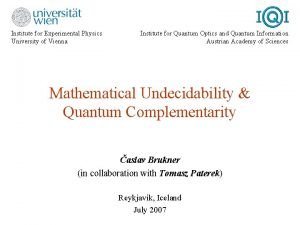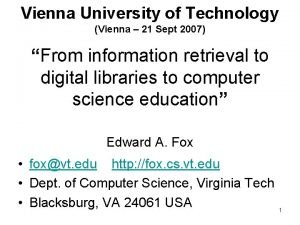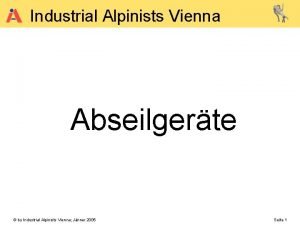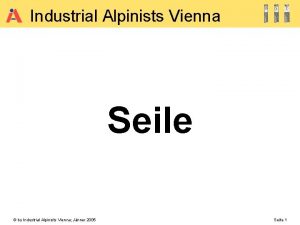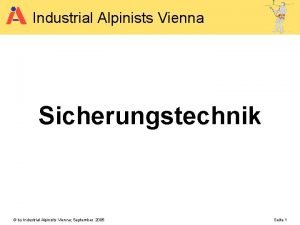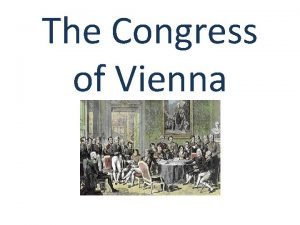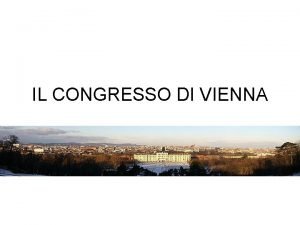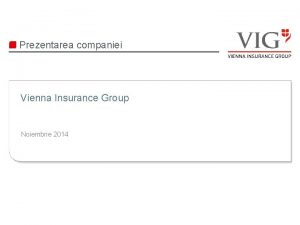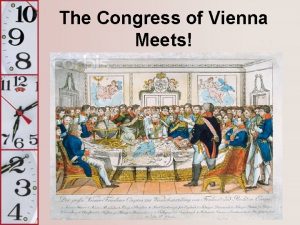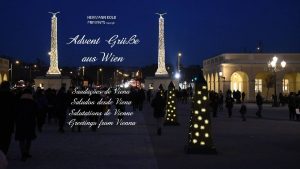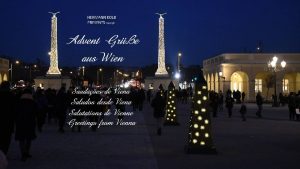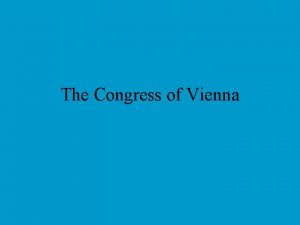Faculty of Physics University of Vienna Institute for














































- Slides: 46

Faculty of Physics, University of Vienna & Institute for Quantum Optics and Quantum Information – Vienna The covariance of physical laws in quantum reference frames Flaminia Giacomini, Esteban Castro, Časlav Brukner Nature Communications 10, 494 (2019), Phys. Rev. Lett. 123, 090404 (2019) Seminar at the Particle Physics Group, Vienna, March 10 th, 2020

Outline § Covariance of physical laws § Quantum reference frame § “Superpositions of spatial translations” § “Superpositions of Galilean boosts” § “Superposition of accelerations” § “The rest frame” of a quantum particle § *Relativistic Spin Qubit § Conclusions

Covariance of physical laws The laws of physics are of “the same form” regardless of the choice of the reference frame. Translations RF RF’ where

Covariance of physical laws The laws of physics are of “the same form” regardless of the choice of the reference frame. Boosts RF RF’ where

Covariance of physical laws The laws of physics are of “the same form” regardless of the choice of the reference frame. RF where A transformation is a symmetry if: RF’ General Transformation

Real reference frames In practice, RFs are physical systems. 10 m A B C Statement from RF A: “The system B is 10 m away from the tree”.

Real reference frames In practice, RFs are physical systems. They ultimately obey quantum mechanical laws. A B Quantum state as seen from RF C Are physical laws covariant under the change of quantum RFs? How to formalize this idea?

Intuitive picture The view from the lab frame: A particle in a superposition in a Mach-Zehnder interferometer The view from the particle’s frame: The Mach-Zehnder interferometer in a superposition *Taken from: R. Angelo, N. Brunner, S. Popescu. A. J. Short, P. Skrzypczyk, J. Phys. A: Math. Theor. 44 (2011) 145304

“Absolute positions” “Background”

“Relative positions”

“Relative positions”

Relative quantities “New QRF” A B “System” C “Old QRF” The description of the quantum state is given in terms of relative quantities. From C: Systems are A and B From A: Systems are C and B

What does not work … “New QRF” A B “System” … is taking both relative coordinates a relative momenta. C “Old QRF” where is reduced mass Not canonical: No guarantees of having the Hamiltonian formalism.

Relative positions We choose the relative quantity we are interested in and then complete the transformation canonically.

“Superpositions of spatial translation” Classical RF: A B Quantum RF: B A Because of : Parameter promoted to an operator Parity-Swap Operator: State of B & C as seen from A State of A & B as seen from C

Examples of “relative quantum states” Localised state of A Entangled state Product state EPR state

Dynamical quantum reference frames A Hamiltonian is assigned to all systems “external” to a QRF. Schrödinger equation in C’s reference frame “New QRF” A B “System” Schrödinger equation in A’s reference frame C “Old QRF” We define a symmetry transformation as: It leaves the functional form of the Hamiltonian invariant.

“Superpositions of boosts” Parity + Swap: Sets velocity of C to the opposite of velocity of A: Galilean boost conditioned by the velocity of A The free Hamiltonian is symmetric under generalized boosts.

Examples of “relative states” System A in a superposition of velocities from the point of view of the initial reference frame C and vice versa. From C: From A:

Weak equivalence principle The physical effects as seen from a reference frame moving with constant and uniform acceleration are indistinguishable from those as seen in a uniform gravitational field. RF RF’ Greenberger operator: D. M. Greenberger, Am. J. Phys. 47. 1 (1979) 35 -38.

Weak equivalence principle for QRFs The physical effects as seen from a reference frame moving in a „superposition of constant and uniform accelerations“ are indistinguishable from those as seen in a „superposition of uniform gravitational fields“. From C: Piecewise linear potential Generalization of the Greenberger operator

From C Weak equivalence principle for QRFs B moves as if it were in a superposition of gravitational fields From A Experimental Tests?

But is it good for anything?

“Moving” in the rest frame Lab’s RF: Photon (B) Atom (A) Transition frequency in the rest frame Doppler shift Suppose that atom’s velocity is not well-defined in the lab frame. Under which conditions can a photon and the atom get in resonance? Lab’s Photon (B) RF: Atom (A) Move in the rest frame. Solve the problem. Move back in the lab frame.

“Moving” in the rest frame Lab (C) Photon (B) Atom (A) Atom’s RF (A) Transition frequency in the rest frame Ground state Lab(C) Photon (B) Atom (A) Lab’s RF (C) Conditional Doppler-shift

Solving an open problem How to encode and decode qubit using the angular momentum of a relativistic particle?

Solving an open problem Move in the rest frame Define spin in the rest frame via the Stern-Gerlach experiment Move back in the lab frame

Summary § Operational approach: reference frames as physical systems obeying quantum mechanical laws § Generalization of the covariance law and symmetries to quantum reference frames § “Superpositions of spatial translations” § “Superposition of Galilean boosts” § Generalization of the weak equivalence principle to quantum reference frames § *A relativistic spin operator satisfying the spin algebra, with the correct eigenvalues and the correct nonrelativistic limit

Thank you! quantumfoundations. org

Stern-Gerlach Experiment Only valid in the non-relativistic limit

Spin in Special Relativity Lorentz boost The alignment of the magnet depends on the momentum of the particle. State of momentum and spin in the rest frame State of momentum and spin in the lab frame Rotated spin Superposition of momenta?

Spin in Special Relativity A general quantum state is written as Move in the rest frame Define spin in the rest frame via the Stern-Gerlach experiment Move back in the lab frame lab spin momentum

Lorentz boost in QRFs spin lab In the rest frame of the particle (A): Lorentz boost by each velocity of the laboratory relative to the particle where guarantees that In the laboratory frame (C): momentum spin

Spin Operator With the QRF transformation, we can operationally identify a spin operator which gives the same results in the laboratory frame and in the rest frame. Correct non-relativistic limit su(2) algebra Correct eigenvalues The state in the laboratory frame

Spin Operator Partition of the total Hilbert space Effectively, we can treat the relativistic spin as a qubit with quantum reference frames!

Summary § Operational approach: reference frames as physical systems obeying quantum mechanical laws § Generalization of the covariance law and symmetries to quantum reference frames § “Superpositions of spatial translations” § “Superposition of Galilean boosts” § Generalization of the weak equivalence principle to quantum reference frames § A relativistic spin operator satisfying the spin algebra, with the correct eigenvalues and the correct nonrelativistic limit

Thank you! quantumfoundations. org

General transformation Transformations from abstract RFs: Function describing the relationship between old and new reference frame, e. g. Transformations from quantum RFs: Hamiltonian of the old RF C as seen from the new one A Time-dependent operator Maping C back to the Schrödinger picture Hamiltonian of the new RF A as seen from the old one C Maping A to the Heisenberg picture Parity operator (switches the equations of motion of A and C)

“Jumping” in the rest frame of a quantum particle Suppose that an atom does not have a well-defined momentum in the lab frame. Under which conditions can a photon and the atom get in resonance? From A (the rest frame of the atom): Photon Atom’s level Lab From C: Photon Atom’s level „Conditional Doppler-shift“

“Jumping” in the rest frame of a quantum particle Suppose that an atom moves with a well-defined momentum in the lab frame. Under which conditions can a photon and the atom get in resonance? Photon Atom’s level Lab Transition frequency in the rest frame Doppler shift

“Jumping” in the rest frame of a quantum particle Suppose that an atom does not have a well-defined momentum in the lab frame. Under which conditions can a photon and the atom get in resonance? From A (the rest frame of the atom): Photon Atom’s level Lab From C: Photon Atom’s level „Conditional Doppler-shift“

Measurements in QRFs The observed probabilities are invariant of the reference frame („generalized Wigner‘s theorem“).

Spin in Special Relativity …and many more!

Spin in Special Relativity Bauke, Ahrens, Keitel, Grobe (2014) Desiderata for a covariant spin operator: § Satisfies the su(2) algebra; § Has eigenvalues ; § Has the correct non-relativistic limit. Problems: § Most of the proposed operators do not satisfy all these criteria § No experimental guidance Important for encoding and decoding quantum information in the relativistic spin. Where is the qubit?

Spin operator With the quantum reference frame transformation, we can operationally identify a spin operator which gives the same results in the laboratory frame and in the rest frame. Pauli-Lubanski operator Foldy-Wouthuysen or Pryce spin operator Correct non relativistic limit su(2) algebra State of the particle in the laboratory frame Correct eigenvalues Bauke, Ahrens, Keitel, Grobe (2014) 11/14

Spin measurement In the rest frame A: spin laboratory In the laboratory frame C: particle 13/14
 University physics with modern physics fifteenth edition
University physics with modern physics fifteenth edition Iit kanpur physics department
Iit kanpur physics department University of split faculty of maritime studies
University of split faculty of maritime studies University of bridgeport engineering
University of bridgeport engineering University of bridgeport engineering
University of bridgeport engineering Hubert kairuki memorial university faculty of medicine
Hubert kairuki memorial university faculty of medicine Semmelweis university faculty of medicine
Semmelweis university faculty of medicine King abdulaziz university faculty of medicine
King abdulaziz university faculty of medicine Mch fsu
Mch fsu Faculty of business and economics mendel university in brno
Faculty of business and economics mendel university in brno Singularity university faculty
Singularity university faculty Agnes csaki semmelweis
Agnes csaki semmelweis Masaryk university medical faculty
Masaryk university medical faculty Feup university of porto
Feup university of porto Ldap cuni
Ldap cuni Faculty of veterinary medicine cairo university logo
Faculty of veterinary medicine cairo university logo Faculty of law of the university of zagreb
Faculty of law of the university of zagreb University of montenegro faculty of law
University of montenegro faculty of law University of kragujevac faculty of technical sciences
University of kragujevac faculty of technical sciences University of cologne faculty of management
University of cologne faculty of management Leading university tuition fees
Leading university tuition fees Hacettepe university faculty of medicine
Hacettepe university faculty of medicine Brown university computer science faculty
Brown university computer science faculty Auricle of heart vs atrium
Auricle of heart vs atrium Semmelweis university faculty of medicine
Semmelweis university faculty of medicine Faculty of engineering lebanese university
Faculty of engineering lebanese university York u my file
York u my file Faculty of economics and business debrecen
Faculty of economics and business debrecen Clemson university electrical engineering
Clemson university electrical engineering Faculty of veterinary medicine cairo university
Faculty of veterinary medicine cairo university Faculty of mechanical engineering thammasat university
Faculty of mechanical engineering thammasat university Mendel university faculty of business and economics
Mendel university faculty of business and economics Masaryk university medical faculty
Masaryk university medical faculty Faculty of public health mahidol university
Faculty of public health mahidol university Facultad de ciencias de la salud uma
Facultad de ciencias de la salud uma Faculty of education khon kaen university
Faculty of education khon kaen university Shawhong ser
Shawhong ser Cairo university faculty of veterinary medicine
Cairo university faculty of veterinary medicine Skobeltsyn institute of nuclear physics
Skobeltsyn institute of nuclear physics Budker institute of nuclear physics
Budker institute of nuclear physics Petersburg nuclear physics institute
Petersburg nuclear physics institute Kirchhoff institute for physics
Kirchhoff institute for physics American institute of physics style manual
American institute of physics style manual Institute of physics ascr
Institute of physics ascr Budker
Budker Vienna conference on instrumentation
Vienna conference on instrumentation Treaty of versailles 1815
Treaty of versailles 1815

